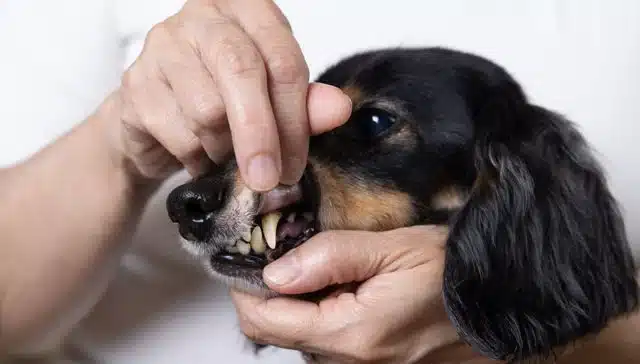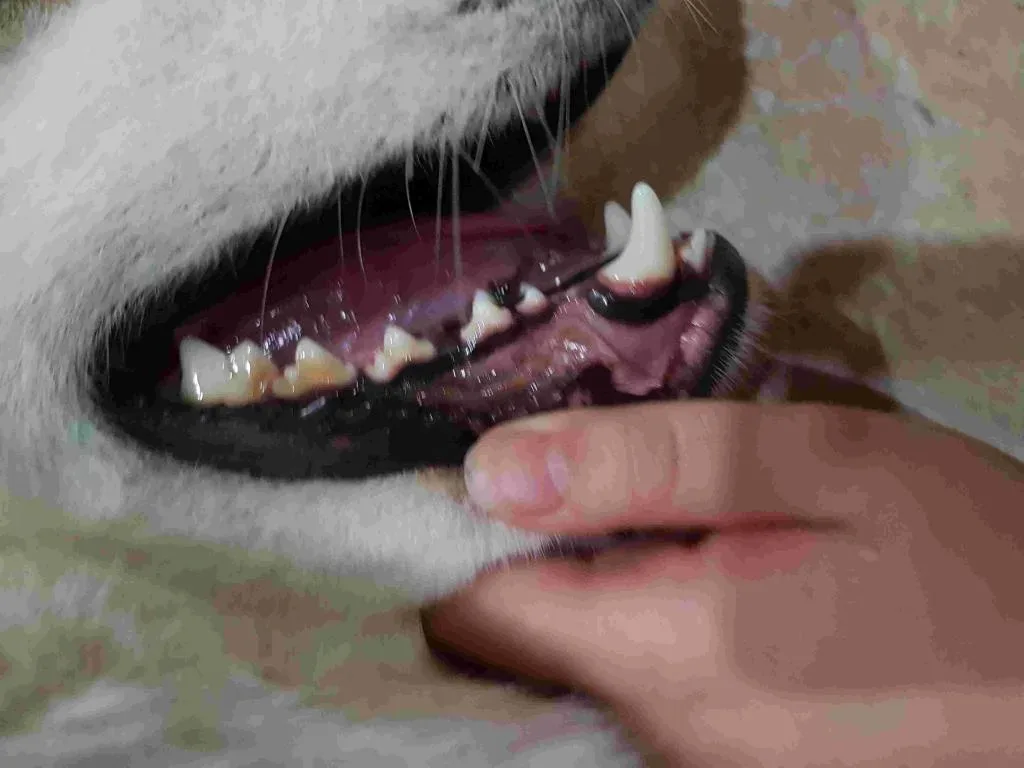When you notice a change in your dog’s oral health, such as black gums, it’s natural to feel concerned. Black gums in dogs can simply be their natural pigmentation, just like humans have varying skin colors. However, if your dog’s gums have suddenly turned black, it could indicate dental issues like gingivitis or other systemic health problems.
Table of Contents
It’s essential for dog owners to recognize when this change is a normal trait and when it’s time to consult a vet.
Genetic and Breed-Specific Influences on Gum Color
Just like people have different skin colors, dogs can have different gum colors. This is often because of their genes. Some dog breeds, like the German Shepherd, usually have darker gums. It’s a normal thing for them and not something that means they are sick.
But, it’s essential to know what is natural for your pet so you can see when something isn’t right. If your dog’s gums change color or if they have other symptoms like not wanting to eat or feeling tired, it could mean they are not well. Then, it’s time to go to the vet. Checking your dog’s gums now and then is a good way to help keep them healthy.
Detecting Warning Signs of Gum Disease
It’s crucial to spot the early symptoms of gum disease in dogs to prevent further health issues. Signs such as inflamed gums, bad breath, and tooth loss should raise immediate concerns. These symptoms can suggest the onset of conditions like gingivitis, which, without treatment, may lead to darkened gums, including black gums.
Additionally, excessive drooling can be a warning sign, often linked to oral infections and should not be overlooked. If you notice these signs, it’s important to consult a veterinarian as soon as possible to address the problem before it worsens.
Remember, a healthy mouth is vital for your dog’s overall well-being, and early detection is key to managing gum disease effectively. Learn more about the indications of why your dog might be drooling and the steps you can take to help your pet.
How to Inspect Your Dog’s Gums at Home
To check for Black Gums in Dogs: Why Did My Dog’s Gums Turn Black?, gently lift your dog’s lips and examine the color of the gums. Healthy gums should be pink, but if you notice darker spots or a change to black, it could be a sign of a health issue.
Ensure good oral hygiene by brushing your dog’s teeth regularly to prevent gum disease. If you’re unsure about the gum color or spot anything unusual, consult your vet for a professional assessment.
When to Consult a Veterinarian

If your dog’s gums change color, it’s important to pay attention. Black gums in dogs can be normal, but if you notice any sudden changes or your dog’s gums turn pale or blue, it’s time to seek veterinary advice. Heavy breathing in dogs, especially when they are at rest, could signal serious health issues. Symptoms to look out for include changes in gum color coupled with heavy breathing, which can be a sign of heart or respiratory problems.
If you observe your dog breathing heavily with pale or blue gums, don’t wait – contact your vet right away. Timely intervention can be crucial for your dog’s health, so always err on the side of caution and get a professional opinion if you’re concerned.
What color gums are concerning in dogs?
| Color of Gums | Concern Level | Possible Causes |
|---|---|---|
| Pink | Low | Normal, healthy gums in most cases |
| Pale | Moderate | Anemia, shock, internal bleeding, circulatory problems |
| Blue/Purple | High | Lack of oxygen, respiratory or cardiac distress, severe shock |
| Bright Red | High | Heat stroke, hypertension, severe inflammation, poisoning |
| Yellow | Moderate | Liver problems, jaundice, red blood cell destruction |
| White | High | Anemia, shock, severe internal bleeding |
| Gray | Moderate | Lack of oxygen, circulatory issues, shock |
| Black | Moderate | Tissue death, necrosis, certain infections, poisoning |
| Bright Blue | High | Severe lack of oxygen, respiratory distress, cardiac failure |
Treatment Options for Black Gums

If your dog’s gums have turned black, treatment varies based on the cause. Professional dental cleaning can remove plaque and tartar that contribute to gum issues. In some cases, medications are prescribed to combat infections or inflammation.
More severe conditions might require surgical intervention. It’s essential to consult a vet for a proper diagnosis to ensure your furry friend gets the care they need. For more insights into canine black gum disease, including home remedies, visit our detailed guide.
Preventative Measures to Keep Your Dog’s Gums Healthy
To ward off gum issues like black gums in dogs, start with daily dental care routines. Brushing your dog’s teeth can drastically reduce plaque buildup. A balanced diet also plays a crucial role, as proper nutrition supports overall oral health.
Don’t forget about chew toys and treats designed to clean teeth and massage gums, which can help maintain a healthy mouth. Remember, prevention is better than cure, and taking these steps can minimize the risk of your dog’s gums turning black.
Is it normal for my dog to have black gums?
Yes, it can be normal for a dog to have black gums, especially if they are a breed with naturally darker pigmentation.
However, if the blackening is a new development, it could be a sign of an underlying condition such as gingivitis or other forms of gum disease. Always consult with a veterinarian if you notice changes in your dog’s gum color.
Can diet affect my dog’s gum color?
While a dog’s genetics typically determine gum color, the diet can influence the overall health of the gums. Nutritional deficiencies can lead to conditions like pale gums, which may indicate a need for dietary adjustments. Offering a balanced diet and proper dental care can contribute to healthier gums.
How often should I check my dog’s gums?
It’s recommended to check your dog’s gums regularly, at least once a month, to monitor for any signs of dental issues or systemic health problems. Look for changes in color, texture, or the presence of lesions. If you notice anything unusual, such as heavy breathing or changes in gum color, it’s important to seek veterinary advice promptly.
Why did my dog’s gums suddenly turn black?
Sudden changes in gum color should be taken seriously. They could indicate a health issue such as gum disease, a reaction to medication, or another underlying condition. For an in-depth look at potential causes. Contact your vet for a proper diagnosis and treatment.
What should I do if I notice my dog’s gums changing color?
If you observe a change in your dog’s gum color, it’s important to assess their overall health. Check for other symptoms like excessive drooling, bad breath, or difficulty eating, which could indicate gum disease or other health issues. Schedule a visit with your veterinarian for a thorough examination and appropriate care.
What are some signs of gum disease in dogs?
Signs of gum disease in dogs include bad breath, swollen or bleeding gums, loose teeth, and difficulty

